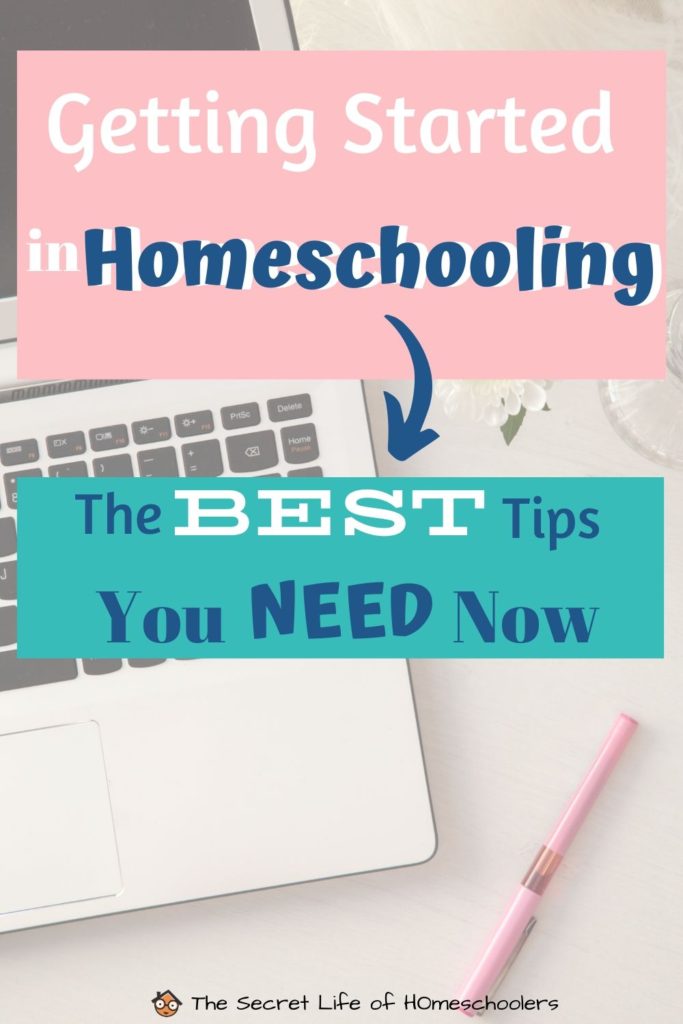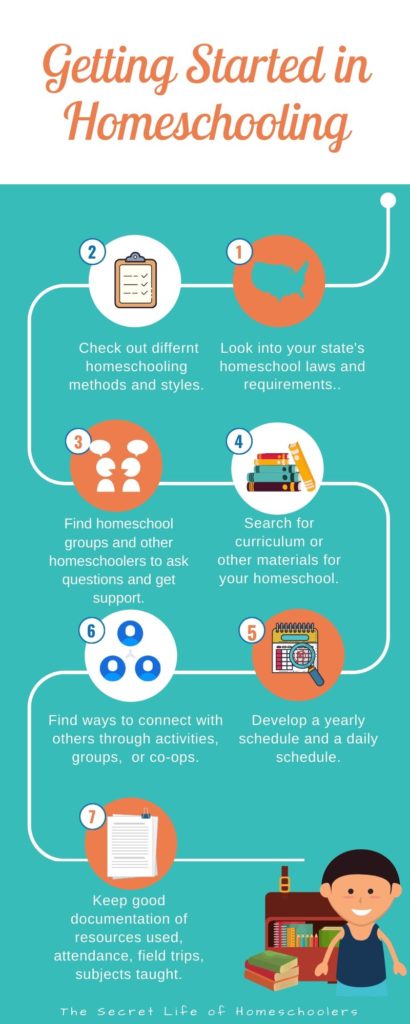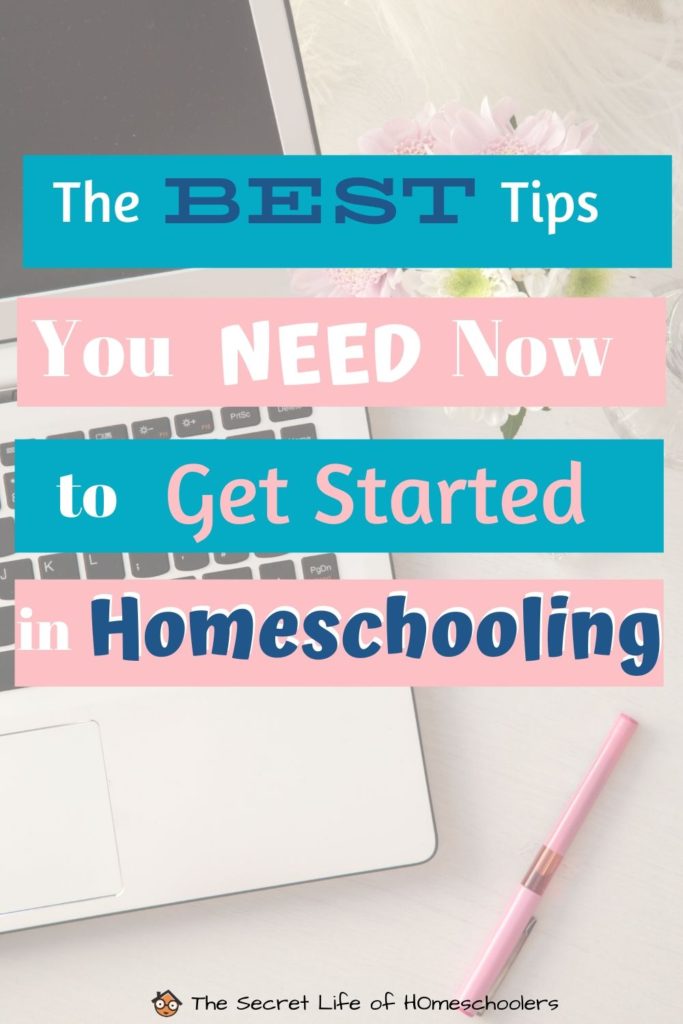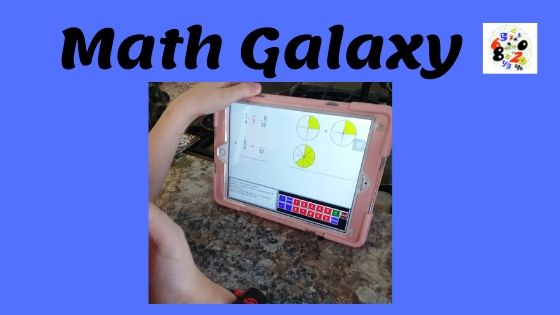Getting started in homeschooling can be overwhelming. Many families get scared or intimidated at the prospect of homeschooling. I get that. I was in your place once upon a time. Don’t let fear keep you from doing what’s right for your family. With a little direction and some encouragement, you can do this. I’m here to help.
The idea of getting started in homeschooling is scary. You are making a choice that is different than the norm. You may not know any families that homeschool or even have family that is on your side. I’m here to tell you it is scary, but it is something YOU.CAN.DO.
A while back, my kids started in public school. It became very evident early on this was not going to work for our kids or our family. It definitely wasn’t working for me. I had the benefit that our family saw our struggles, so they completely understood why we were doing it. They didn’t fully know what it meant, but they knew it was a better option for our kids. Friends and former teacher colleagues, not so much, but I didn’t care.
If you want to homeschool your child, the number one thing you need to homeschool is the desire to try your hardest to give them the education they need and deserve. From there, you can figure it out.

How to Get Started in Homeschooling
Tip 1: Research
Maybe it’s because I was a history major or maybe it’s because I love learning, but research has always been my number one way of dealing with something new and scary. Research can help dispell your fears. We usually fear what we don’t know a lot about. Information is powerful.
Where do you start, though?
Find Out the Laws and Requirements for Homeschooling in Your State.
You can find your state’s homeschooling laws by searching your state’s Department of Education page. You may also find the HSLDA (Home School Legal Defense Association) page helpful, too. They break down the laws in each state in an easy to read format.
In my state, we need to file a one-time letter of intent to homeschool and then a subsequent letter to homeschool the following years. We must include a year-end assessment (standardized testing or portfolio) with the letter, too. My family does standardized testing. You can explore these two options more at Testing or Portfolio: What Is Best for Your Family?

Do a Google Search for Homeschooling Groups in Your Area or Beyond.
You may be thinking, “If I’m not homeschooling yet, why should I join homeschooling groups?”
Well, I would suggest starting with Facebook groups. I belong to several homeschooling Facebook groups. Some groups are local (around my town and in my state), and others are homeschooling support groups not specific to our area.
I love the groups I have joined. I can find other homeschoolers in my area, events for homeschoolers to take part in, and ask questions and get help in our homeschool journey. It helps even when you are just thinking about getting started in homeschooling. It will help bolster your confidence when you talk with other families who are homeschooling.
In your research, you will find other families to connect with or find groups where you can get advice. The other amazing thing is you will see all the resources out there for homeschooling families. You won’t feel so alone and in the dark.
Homeschool Mission Statement
One important thing you need to consider when getting started in homeschooling is a Mission Statement. I didn’t think of doing this right off, and I wished I had.
You may be wondering what a mission statement is. A mission statement explains your vision for your homeschool, your values, and your goals.
To help you understand a mission statement a little better, here is an example:
- Our homeschool will be a place of active learning with as much real-world experience as possible. Our children will understand how learning applies to their life. It is our goal for our children to understand learning is all around them, how to learn and think critically for themselves and strive to be life-long learners.
Your mission statement gives you a clear purpose. You know what to focus on and how you might want to go about setting up your homeschool year.
If you want to read more about the importance of a mission statement, hope over HERE. You’ll see why it can be so helpful.
Homeschool Methods and Styles
Okay, so another thing you need to research is what your homeschool style and method will be because it is so important to know this when you start the planning stage.
If you search homeschool styles or homeschool methods, you will get A LOT of results. It is overwhelming. I freaked out because it was too much. The best thing I did, though, was find an approach I wanted to take with homeschooling. I was lucky a friend pointed me in the right direction.
I’m serious. Once I found a homeschool method I liked, everything became a little easier.
How do you find what style would fit your family?
I’m not going to go into a summary of all the different methods here. I will point you in the right direction, though. I find this quiz HERE can be very helpful, and this summary HERE is a good resource to read a brief overview. It will help give you a sense of the method or methods that may work best.
Now that you have a method or a style, you can really start planning. The different method you choose will have books and sites dedicated to that approach. In your reading, you will find curriculum suggestions and sample schedules.
For us, we like the Classical Education method. I bought Susan Wise Bauer’s book The Well Trained Mind. It was my guide and still is today. However, I stray a little more and don’t stick to it 100%. I can, now that I’m more comfortable homeschooling.
Okay, so now you know your state’s homeschooling laws. You may have joined some groups to get some answers, and you know your homeschooling method. You are ready to take the plunge!
Now what?!
Tip 2: Choosing Your Curriculum
As I mentioned above, once you have an idea of what approach you want to take with homeschooling, it is easier to find the curriculum you want to use. Many homeschooling methods have suggested curriculum, but there are other options, too.
- All-in-One: Many companies sell complete packages. You choose the grade level, and they provide all the materials for each subject.
- Unit Studies: These focus on a topic like weather, plants, a particular book. You focus on the topic for a few weeks.

If you want to research different curriculum more, check out these sites:
- Cathy Duffy’s Reviews. She has many reviews for each subject area. You can find information on many different curriculum options and which ones she ranks as one of the best.
- Homeschool Review Crew: At this site, you can find a large number of reviews on different homeschooling curriculum and resources. These are real homeschool parents that have tried the products and share their thoughts. I loved this site so much, I began working with them as a reviewer this year. ?
- Secular Homeschool: I know many families struggle to find a secular curriculum. This site lists various secular curriculum options.
I have also shared many different curriculum choices and resources we use in our homeschool. Take a look under my Curriculum and Resource page under Homeschooling in the menu bar or click HERE. You’ll find, not only curriculum options but supplemental resources, too.
Tip 3: Planning
I won’t lie, planning your homeschool year is a daunting task when you are just getting started in homeschooling. It is also the fun part. Well, I think so. Some may say it isn’t fun. Planning is great because you can plan what you are going to do, what your schedule will be, and how you will teach the information. It is so exciting.
Schedule
When it comes to your homeschooling schedule you have two things to consider:
- Yearly Schedule
- Day-to-Day schedule
Yearly Schedule
Here are some questions to consider:
- Are you going to follow a traditional school schedule?
- Will you homeschool year-round?
- Do you want to homeschool and take breaks as your family needs them?
- Are you going to follow a schedule of six weeks on and a week off?

There are many ways families homeschool. One of the first things to consider is how many school days your state requires. You can begin to play around with the calendar to see how you can fit in all the required days.
Our family does schooling year-round. You can read more about why we choose to HERE.
Another thing to consider is your curriculum. The curriculum is usually designed to be taught in a certain number of weeks. Some are set up to be taught in 32, 36, or even 42 weeks. You’ll need to see how you can fit the curriculum into a schedule that will work for you.
Most people have an idea right off if they plan on teaching until the curriculum is completed, follow a traditional school schedule with a certain number of school days, or schooling all year. Once you have an idea of what you want to do, you can map your year out.
Day-to-Day Schedule
Now that you have an idea of what your yearly calendar will look like you can take a look at your day-to-day schedule. There are a lot of options. Here are a few types of scheduling:
- Block- The day is broken into chunks of time when you will teach certain subjects.
- A loop schedule- You make a list of the required things you must cover each day and add extras at the bottom. You keep following your options for the day and pick up where you left off the next day.
- Relaxed- Kids work on things when they’d like throughout the day. (We use this approach.?)
It takes some time to find a schedule that suits your family. It may change over time, too. I have had to change our schedule over the years and even in the middle of a school year. Different seasons bring different needs. The beauty of homeschooling is you can make the changes you need at any time.
Tip 4: Homeschooling Space
When you are looking at how to get started in homeschooling, it is important to consider a homeschooling space. You will want somewhere to keep all your materials and a place to keep all your records (I’ll talk more about record-keeping in a moment).
Some people are lucky to have a homeschool room. I am one of them. It is the addition we built on for my former preschool. We love having the space to spread out and keep all our homeschooling materials.

If you can’t have a designated room, at least have some shelves set aside where all your books, supplies, and records can be kept. It will make things a lot easier if it is kept all in one spot.
Tip 5: Record Keeping
In order to satisfy many state requirements, you need some records to show you are providing an education for your kids. Before your first day of homeschooling, SET UP A RECORD KEEPING BINDER OR FILE FOLDER! You will regret it if you don’t keep on top of your records.
Generally, these are things you want to keep records of:
- Attendance– Record the days you do school activities.
- Curriculum and Resources– You’ll want to write down the curriculum and other teaching materials you use for each subject. It is your proof you are educating your kids.
- Reading Lists- It’s a good idea to keep track of the books your kids read and read-aloud books you’ve done as a family.
- Work Samples– Even if you don’t keep a portfolio, it is a good idea to save some work samples throughout the year from all the subjects your state requires. This proves your kids are learning and making progress.
- Field Trips– It’s a great idea to keep a record of all your field trips. Not only is it a fun thing to look back on, but it shows all the learning opportunities you took advantage of.
- Extra-Curricular Activities– Sometimes people forget that many of the extra-curricular activities our kids take part in will also count towards their education requirements. Keep a record of it.
****To help get started with record keeping, here are two files you can download to get started. ****
Getting Started in Homeschooling- You Are Ready
After taking all the steps above, you are ready to get started in homeschooling. Trust me. You are.
Click the Download button below for your copy of Getting Started in Homeschooling infographic to help you through the process.

Is homeschooling as scary now?!
Probably not.
The scariest part of homeschooling is taking the leap and saying you will do it. Once you do research, get advice from others, and plan things out, it will become less scary. It really will.
You will doubt yourself along the way. We all do. That is why I HIGHLY recommend finding ways in person or online to connect with other homeschooling moms. You need each other’s support and encouragement along the way.
You now have the tips you need to get started in homeschooling. You.Can.Do.It.





